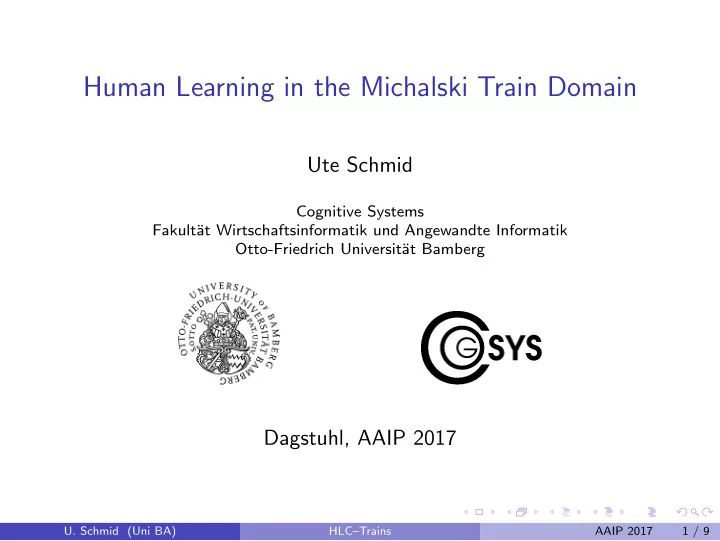

Human Learning in the Michalski Train Domain Ute Schmid Cognitive Systems Fakult¨ at Wirtschaftsinformatik und Angewandte Informatik Otto-Friedrich Universit¨ at Bamberg Dagstuhl, AAIP 2017 U. Schmid (Uni BA) HLC–Trains AAIP 2017 1 / 9
Human-like Computing Make (AI) algorithms/programs work similar to human cognitive processing WHY? ◮ because humans (still) are better than AI systems in some domains – try to understand, how humans do it (’psychonic’) ◮ because HCI moves from either simple information systens or full automated systems to companion systems (human-computer teams) and therefore, computational and cognitive mechanisms has to be compatible Gain novel/deeper insights into (high level) human cognitive processes ◮ Empirical studies ◮ Cognitive models individual, e.g. for tutoring or average U. Schmid (Uni BA) HLC–Trains AAIP 2017 2 / 9
Empirical Studies on Human Inductive Learning Are learned models comprehensible/operational effectiv? Experiments concerning comprehensibility of ILP learned rules with/without predicate invention (family tree domain) ◮ Ute Schmid, Christina Zeller, Tarek Besold, Alireza Tamaddoni-Nezhad, Stephen Muggleton (2017). How does Predicate Invention affect Human Comprehensibility? Post Proceedings ILP’16 , Springer. → talk by Stephen ֒ ◮ Additional experiment: unknown, complex domain (chemistry) ◮ current experiment with non-computer science students, natural language style rules Study on effect of giving explanations (the learned rules) on trust and transfer And: learning in the Michalski train domain joint work with Jonas Troles and Johannes Birk (BA Psy), Christina Zeller U. Schmid (Uni BA) HLC–Trains AAIP 2017 3 / 9
The Michalski Train Domain U. Schmid (Uni BA) HLC–Trains AAIP 2017 4 / 9
The Michalski Train Domain (2) originally introduced by Larson & Michalski to explore human learning (ct. Bruner, Goodnow & Austin) Competition with different sets of trains in 1994 (Michie, Muggleton) domain involving discrete valued features as well as relations Learning quite complex (recursive) rules Question: How good are humans in learning such complex rules? Based on Bruner et al. findings (1959, A Stuy of Thinking): conjunction of features, known as (easily) learnable, disjunction of features, known as highly difficult for humans Additionally: relation between features (of two cars with fixed ’distance’) and recursive relation U. Schmid (Uni BA) HLC–Trains AAIP 2017 5 / 9
A Difficult Rule Learned by Metagol Eastbound: First waggon is closed or somewhere in the rest of the train is a triangle load and first car is also short and the rest of the train is eastbound U. Schmid (Uni BA) HLC–Trains AAIP 2017 6 / 9
Rules to be Learned in our Experiment Trains with a strongly reduced set of features ◮ trains with three to seven waggons ◮ only three features: length (long/short), form (rectangle, oval, trapezoid), load (square, triangle, circle) Training sets: 5 east and 5 west To be learned rules (in a between subject design) ◮ conjunctive: first waggon load is triangle and third waggon has form oval ( n = 10) ◮ disjunctive: first waggon load triangle or third waggon has form trapezoid ( n = 9) ◮ relational: any waggon form is rectangular immediately followed by a waggon with load triangle ( n = 10) ◮ recursive: first waggon form is rectangle and a waggon somewhere behind has load circle ( n = 9) Test phase: 10 new trains (6 east, 4 west) U. Schmid (Uni BA) HLC–Trains AAIP 2017 7 / 9
Results U. Schmid (Uni BA) HLC–Trains AAIP 2017 8 / 9 differences between conjunctive/recursive and disjunctive/relational
Interpretation The classic result concerning conjunctive and disjunctive rules has been confirmed within the train domain Recursive rule has been learned easily: fixed anchor first waggon and somewhere behine seems to be a natural concept Relational rule is of similar difficulty as disjunction: problem might be less immeadiately identifyable constraints U. Schmid (Uni BA) HLC–Trains AAIP 2017 9 / 9
Recommend
More recommend